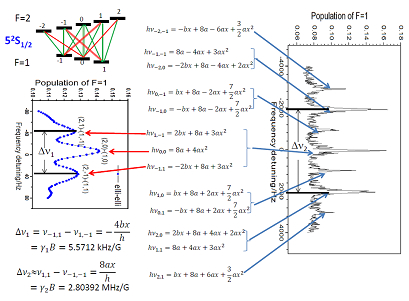[ China Instruments Network Instrument Development ] Recently, the Weirong Group, a researcher of the Quantum Optics Laboratory of the Shanghai Institute of Optics and Fine Mechanics, Chinese Academy of Sciences, has made a series of progresses in magnetic field evaluation and metrology of cold atomic fountain bells.

The stimulated Raman transition energy spectrum of the 87Rb ground state and the corresponding Zeeman splitting
The electromagnetic field is one of the most basic forms of matter. The magnetic field influences the energy level of particles through the Zeeman effect and is one of the most important factors affecting the atomic clock and other precision measurement fields. Related fields induce energy level split testing magnetic fields through a first-order Zeeman effect. Based on the stimulated Raman transition method, researchers explored the selection rule for two-photon transitions (not only ΔmF=0, ±1, but also increase ΔmF=±2), combined with different frequency of first-order and second-order Zeeman effects. Sensitivity coefficient, second-order Zeeman effect, weak magnetic sensitivity transition test magnetic field. It is combined with the strong magnetosensitive transition of the first-order Zeeman effect, which is equivalent to providing a dual-range magnetometer with a 500-fold difference in magnetic field measurement, which greatly expands the testing range of magnetic field strength. Using this method, researchers evaluated the magnetic field strength of the entire thrown area of ​​the fountain clock and realized high-precision magnetic field measurements in the 104 dynamic range. The relevant research results were published in Applied Physics Letters [106, 152402 (2015)].
The magnetic field is a vector, which makes the direction measurement of the magnetic field an important task. The Zeeman effect magnetic field test based on atomic energy level splitting is quite different from the ordinary Hall effect magnetometer. The Hall effect magnetometer is the projection of the test magnetic field vector in the test direction, and the energy level splitting caused by the Zeeman effect depends on the size of the magnetic field. Its effect on the particles is reflected by the CG coefficient, which is the intensity of the transition. By describing the tensor relationship between the optical field and the static magnetic field, the researchers analyzed the relationship between the intensity of the stimulated Raman transition and the tensor of the static magnetic field, and measured the transitions between different Zeeman levels caused by the polarization-controlled Raman laser. Intensity, the axial and radial projections of the static magnetic field in the fountain clock were tested and a remote measurement of the magnetic field vector was achieved. The test accuracy is measured in the axial direction in the order of millimeters of arc, and reaches 0.1 arc in the radial direction. Related research results were published in Applied Physics Letters [108, 122401 (2016)].
Based on the above work, researchers have conducted research on the measurement of magnetic field strength from the measurement to the control. Fountain clocks and other devices have very strict requirements on the magnetic field homogeneity in the cold atom phase discrimination region. However, because of materials, processes, etc., the actually completed devices cannot fully meet the requirements of design expectations. In response to the spatial fluctuation of the magnetic field, the researchers proposed a method of magnetic field dynamic compensation to improve the magnetic field uniformity perceived by the atom. This method solves the effects of hysteresis effects and effectively suppresses the magnetic field fluctuations (5nT to 0.4nT) experienced by the atomic flight, making the contribution of correlation effects to the uncertainty of the fountain bell decrease by about one order of magnitude. Related research results were published in the Review of Scientific Instruments [89,033110 (2018)].
The method was also extended to the 10m fountain interferometer of the Wuhan Institute of Materials Science and Technology, Chinese Academy of Sciences. This project was funded by the Chinese Academy of Sciences' strategic pilot technology project (XDB21030200).
(Title: A series of progresses have been made in the evaluation and measurement of the magnetic field of the fountain bell at Shanghai Optomechanics Co., Ltd.)
Sanitaryware Commode,Bathroom Commodes,Ceramic Commodes,Toilet Commodes
Jiangyin Huashi Medical Equipment Co.,Ltd , http://www.medicalwellcare.com